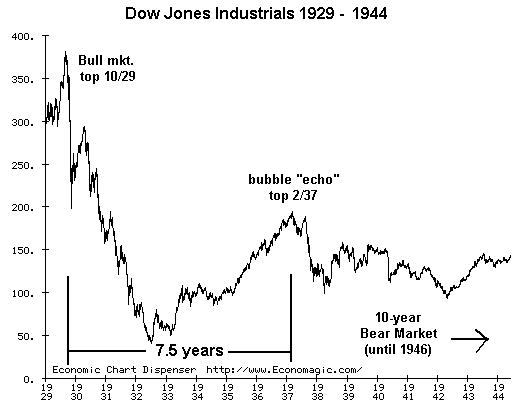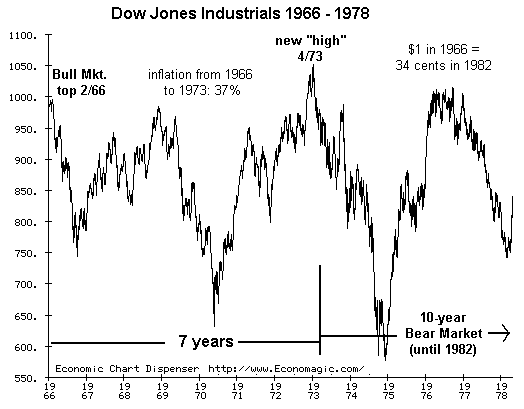

|
| weblog/wEssays archives | home | |
|
Insanity and Complacency (July 19, 2007) Maybe you've had this experience, too. You start talking about the coming Great Unraveling / Depression and your friend/relative looks at you with an odd expression, e.g. "this guy is nuts." Since I have friends all over the country, as do many of you, no doubt, I know this isn't a California phenomenon. Regardless of where they live--Virginia, Massachutsetts, Florida, you name it--real estate is fine, sales are positive and prices are stable or still rising. Ditto the economy. Everyone I know (other than you, dear readers, who I have met via the Internet) is absolutely complacent about their personal lives, the nation and the planet. Sure, there are problems, but there are always problems; so what's different? What's different is the supreme complacency at the Wintry end of a long cycle of history. I have written about various cycles recently, and knowledgeable reader Matt S. was kind enough to recommend a book on just such a long cycle: The Fourth Turning Before we get to the book, let's consider an example of the insanity/complacency disconnect which was submitted by frequent contributor U. Doran: BOSTON'S CRUMBLING ECONOMY. The writer of the piece just walked around his central Boston neighborhood, snapping photos of all the retail and commercial spaces for rent. There are 30 such photos. I have commented in the past on the hollowing out of our local downtown--not just local businesses, but chains: Eddie Bauer closed a few years ago, and now a huge Barnes & Noble bookstore has closed. How can the stock market be hitting new "highs" (see yesterday's entry) while bricks and mortar America is filling with empty storefronts "in these prosperous times"? I know the standard answer is the stock market is weighted to companies like IBM and Coca-Cola which reap most of their sales and profits overseas. In other words: the U.S. can be a garbage heap of consumer debt and local financial ruin, and the market will be lovin' it because the Global 500 don't need the U.S. consumer to make scads of money. Perhaps. But since the U.S. is still 30% of global GDP, and virtually every overseas "powerhouse" (Germany, Japan, China, etc.) is an export-based economy (i.e. depending on selling to someone overseas rather than to their own citizens), all of those overseas companies and workers still depend on the U.S. consumer for their pricing power and profits. So the dragon eats its own tail. IBM is making big bucks selling to non-U.S. corporations who are prospering from selling to the U.S. consumer and to the E.U. and Asian exporters, because the E.U. and Asian exporters are ultimately prospering by selling to the U.S. consumer. Any way you slice it, it all comes back to the 70% of the U.S. economy (20% of the entire global GDP) which is U.S. consumer spending. I won't go into a long economic explanation here, but please note that if you lose 10% of your sales, and your competitors lose 10% of their sales, then you've all lost pricing power which means you've lost profitability. The global supply chain has been pared to the bone, so forget "cutting production and transportaion costs." Those are both on the rise globally. This is why the global economy will roll over when the U.S. consumer rolls over: the domino effect of non-U.S. workers, governments and exporters ultimately depending on sales to the U.S. for their profits and pricing power. As for the argument that China is rapidly morphing into a consumer economy which doesn't need overseas markets--there is no evidence to support this fantasy, as I outline in Can the U.S. Go Down and China Stay Up? (June 5, 2007). So the argument that the U.S. consumer and retailer can dry up and blow away without affecting the global economy or U.S. corporate profits (rising double-digits for 5 years running, with no end in sight!) is simply unsupported by data. Here's what Matt had to say about The Fourth Turning: As for the 4T, the basis for the theory is pretty simple - as the oldest people in a society die off, most of the wisdom and experience they have goes with them - thus people tend to make the same decisions and mistakeds over and over again (history rhymes idea). And the cycle length is generally around 80 years, what the authors call a saeculum, the length of a long human life. Each of the 80 year cycles get split up into 20 year generations, so we have the GI's (now leaving life ), the Silents - born from around 1925 to 1945, the Boomers, the Gen Xers, the Millenials (another round of GI's) and now the Homelanders (another round of Silents).Thank you, Matt, for the recommendation and commentary. The book's authors make a strong case for an 80-100 year cycle of human history which ends in a transformative crisis. In American history, the cycle's eras are: I have described the Kondratieff cycle, which suggests a financial/economic bottom around 2012-2014, and The Rhythm of War which suggests an alignment of cycles in the decade 2020-2030. I have also noted how post-bubble stock markets tend to have a "echo bubble peak" seven years after the initial bubble bursts (1929 - 1937, 1966 - 1973); after this echo bubble bursts, a long period of malaise/decline kicks in. (see charts below) I agree with Matt that peak Oil and the global jockeying for declining resources (oil, water, food) could easily set the stage for a global conflagration around 2021. I would add the potential for war between China and Taiwan and between Pakistan and India as possible flashpoints. I recommend checking out The Fourth Turning (at your library, if they own a copy) for a thought-provoking and sobering "long view" of American history and the coming two decades. 

Though the mainstream financial press and cheerleaders don't mention it, note that the stock market bubble blew up in March 2000. Add 7.5 years and you get September 2007 as the bubble-echo meltdown target. But never mind history; this time it's different, and we're in a 20-year cycle of prosperity and permanent low interest rates. Oh, and housing has bottomed, and there's never a better time to buy anything/everything than now. For more on this subject and a wide array of other topics, please visit my weblog. copyright © 2007 Charles Hugh Smith. All rights reserved in all media. I would be honored if you linked this wEssay to your site, or printed a copy for your own use. |
||
| weblog/wEssays | home |